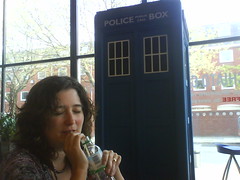“At the end the comandante raised his arm in the Fascist salute. ‘¡Arriba España!’ In the early days of Bernie’s captivity, at San Pedro, many prisoners had refused to respond, but when a few were shot they had complied, and now there was a dull ragged response. Bernie had told the other prisoners about an English word that sounded almost the same as ‘Arriba’ and now it was ‘Grieve España’ that they called back.”
CJ Sansom, Winter in Madrid, p. 256.
Mother-in-law leant us this, which gripped when I should have been reading work things. It’s about three public school boys, caught up in Spain after the civil war, as Franco debates whether or not to go in with Hitler.Bernie Piper is the son of a shopkeeper, in Spain to fight for the reds against fascism. Missing, believed dead, he’s in a work camp in Cuenca, slowly toiling to death, destroying pagan cave paintings. (This might constitute a spoiler were it not also revealed in the back-cover blurb.)
Bernie's grieving girlfriend Barbara has been taken up by the Clark-Gable-moustached spiv Sandy, who got expelled from the old school and never got on with Bernie. Sandy’s up to something mischievous involving gold mines and Jewish refugees. So another school mate, hero and Dunkirk veteran Harry Brett, is sent out to spy on Sandy.
It packs in the historical detail, explaining the power groups, economics and cultural nuances to build up a vivid picture of these terrible times. There also some fun gags involving real historical characters. All this helps flesh out an engrossing plot, and the last 100 pages are especially hard to put down. The Dr was a little disappointed by the abruptness of the ending; I thought it effectively placed the whole thing in the context of the rest of the war.
The 4½-page historical note is and one of best and most concise summaries of the period I’ve seen. But the novel itself explores the splits between what are ostensibly two sides. The British-bribed monarchists vie for power with the fascist Falange, while Bernie’s as much at risk from his fellow communists as he is his captors. And at its heart are those with no particular leanings, ordinary, decent, everyday people helplessly caught up in the horrors.
The acknowledgments don't mention Orwell or Hugh Thomas - which is pretty much all I know about this most uncivil of wars. But I'm intrigued by a couple of the other sources:
“Phillip Knightley’s Philby, KGB Masterspy (London 1978) opened the world of wartime espionage for me […] The article by J. Bandrés and R Llavona, ‘Psychnology in Franco’s Concentration Camps’ (Psychology in Spain, 1997, vol. I, no. I, pp. 3-9) is a chilling account of the abuse of psychiatry.”
Ibid., p.537.
There are posters in the train stations all over London enthusing about Sansom’s other books, and one day when I’m not reading for money I shall endeavour to look them out.












